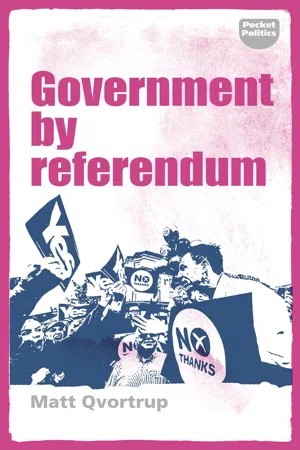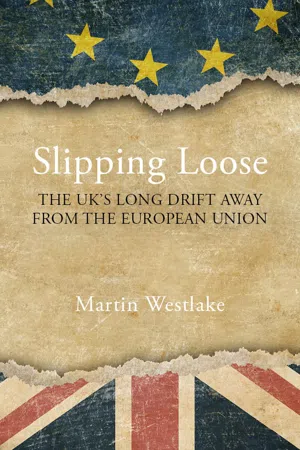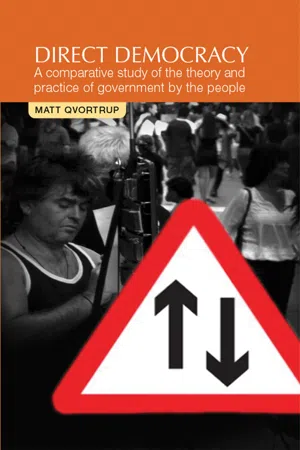History
Referendum 1975
The 1975 referendum in the United Kingdom was a national vote on whether the country should remain a member of the European Community (EC), which is now known as the European Union (EU). The majority of voters chose to stay in the EC, with 67% in favor of remaining. This referendum marked a significant moment in the UK's relationship with the EU.
Written by Perlego with AI-assistance
Related key terms
7 Key excerpts on "Referendum 1975"
- eBook - ePub
- Matt Qvortrup(Author)
- 2018(Publication Date)
- Manchester University Press(Publisher)
And, of course, Attlee’s refusal was not based on political philosophy, let alone on a careful study of continental constitutional practices at a time when referendums were used extensively by very credible democratic governments. But the argument worked. That is in the nature of political rhetoric: principles, arguments and seemingly erudite references to foreign constitutional practices are used to pursue political ends.All this was literally academic at the time. The referendum was not seriously debated until the end of the 1960s. The change in constitutional doctrine happened as a result of the schism over membership of the EEC.Referendums in the 1970s It was not until 1973 that the first major referendum was finally held in Britain, with previous attempts limited to local polls, such as that on temperance in Wales.After the outbreak of hostilities in Northern Ireland, the Conservative Prime Minister Edward Heath decided to submit the future of the province to a verdict by the people. Voters in the province were asked, ‘Do you want Northern Ireland to remain part of the United Kingdom?’ The Catholic minority boycotted the referendum; thus the outcome was not reflective of the will of the people. On a 58 per cent turnout 98 per cent voted to remain part of the United Kingdom. The referendum merely cemented the demographic realities, and arguably prompted the more radical among the nationalist or Catholic minority to resort to violence and terror. Not for the first time blunt majoritarianism led to strife and exacerbated the conflict. But the Border Poll received little coverage, particularly compared to the following major referendum in 1975.In the light of more recent history, it is thus instructive to look at the referendum on EEC membership that took place in the mid-1970s. Not because history repeats itself, but rather to show that it does not, and – perhaps – to warn subsequent generations not to believe complacently that the past is a guide to the present.History lessons from the 1975 referendum?To understand why the referendum came to the fore in the early and mid-1970s requires us to look at the whole political ecology at the time. The referendum was not merely a result of one specific development. It was not caused by a single event, rather it emerged as a result of an interplay of different factors; ‘In sum’ … ‘history is not a chain of independent events’ (Steinmo 2008 - eBook - ePub
Slipping Loose
The UK's Long Drift Away From the European Union
- Martin Westlake(Author)
- 2019(Publication Date)
- Agenda Publishing(Publisher)
As a contemporary study reported, the result was “unequivocal, but it was also unenthusiastic. Support for membership was wide, but it did not run deep” (Butler & Kitzinger 1976 : 280). Space precludes a detailed analysis here (although see Chapter 7), but in the light of what has subsequently occurred the importance of the 1975 referendum cannot be overestimated. Five particular aspects should perhaps be underlined. To begin with, the referendum was the first-ever national plebiscite in British politics – ever. The longstanding eschewal of direct democracy was no more. The principle that a referendum might be held had been acknowledged by parliament, sovereign though it had always been and would always remain, through the Referendum Act 1975. The distance between opposition to, or acceptance of, that principle was clearly far greater than the distance between acknowledging that a referendum might be held and arguing that a referendum should be held. The 1975 referendum was undoubtedly the thin end of a wedge. Second, no matter what the language used about the consultative nature of any referendum result, the potential for discordance between what a majority of MPs, on the one hand, and a majority of the people, on the other, believed had been irrevocably created. In 1975, those two majorities happened to concur; in 2016, they did not. That one day they might not, whatever the question, was always a possibility from the moment the principle of the 1975 referendum was conceded by the British parliament. As of 1975, the dangerous potential for dissonance lurked. Logically, any parliament would have to bow to the majority view of the people it purported to represent - eBook - ePub
The British political elite and Europe, 1959-1984
A higher loyalty
- Bob Nicholls(Author)
- 2019(Publication Date)
- Manchester University Press(Publisher)
6The 1975 referendum on EEC membershipThe general election of February 1974 resulted in Labour being the party with the most seats, and Harold Wilson once again becoming Prime Minister. The decision to hold a referendum was made to secure Wilson's main aim of maintaining party unity. As a result of the Wilson government's decision to campaign for a Yes vote and thus achieve the government's desired outcome of remaining in the EEC, the left of the Labour Party was consequently in a far weaker position, not only on Europe but on other domestic issues. Politicians took a particular stance on the issue for motives that were varied and often complex. Evidence suggests, for example, that the reason for Enoch Powell's volte-face on Europe was not based on a principled shift of view, but was instead a personal attack on Heath. The debate over Europe not only lacked quality, but also for many members of the political elite, Europe was subordinate to party, career or electoral considerations. The repercussions of the referendum proved to be meaningful for the Labour Party in particular, as the electorate's decision deepened the cleavage between the left and right of the party and created severe long-term problems for Prime Minister Wilson.The holding of a referendum in June 1975 on Britain's continued membership of the European Community was in itself a victory for the anti-Marketeers. This was a very short-lived success, however, as the electorate voted by seventeen million to eight million in favour of membership, the outcome of which was a major defeat for the anti-European cause. The referendum to determine whether Britain stayed in or came out of the Common Market was crucial in more ways than one. The outcome of the vote committed Britain to European integration: the British public had now given its consent and therefore the referendum legitimised Heath's decision to take Britain into Europe. Labour's Ted Short justified holding a referendum when he stated in the House of Commons in March 1975, ‘the issue continues to divide the country. The decision to go in has not been accepted. That is the essence of the case for having a referendum’ (Hansard, 11 March 1975, Vol. 888, c. 292). As a result of the referendum, the issue of Europe ceased to divide the nation. ‘The decision to stay in the EEC was accepted; and to that extent, the device fulfilled precisely the purpose it had been assigned’ (Butler and Kitzinger, 1976 - eBook - ePub
Scotland Decides
The Devolution Issue and the 1997 Referendum
- Hugh Bochel, David Denver, James Mitchell, Charles Pattie(Authors)
- 2013(Publication Date)
- Routledge(Publisher)
8The Referendum in Context
REFERENDUMS IN THE UNITED KINGDOM
By late 1998 seven significant referendums had been held in the United Kingdom.1 The first-ever (and so far only) United Kingdom-wide referendum took place in June 1975 on the question of the country's membership of the European Community. It was followed in 1979 by votes on devolution in Scotland and Wales but thereafter, with the Conservatives in power, there was no recourse to a referendum for 18 years. The new Labour government elected in May 1997 was much more interested in constitutional reform than the Conservatives had been, however, and more willing to hold referendums. The 1997 Scottish referendum was the first in a series initiated by the government. In little more than 12 months, in addition to the Scottish case, referendums were held on the creation of an Assembly for Wales (18 September 1997), reforming the government of London to allow for an elected mayor and a Greater London Authority (7 May 1998) and on the proposals for Northern Ireland contained in the ‘Good Friday Agreement’, which related to the system of government as well as to other matters (22 May 1998). Further referendums are promised on other issues including reform of the electoral system, United Kingdom entry into European economic and monetary union and, possibly, the setting up of regional assemblies within England.As the constitutional commentator Geoffrey Marshall has remarked, this new-found enthusiasm for referendums is ‘a curious turn of events’ (Marshall, 1997). It is curious because most British politicians and most constitutional experts have, in the past, been hostile to the use of the referendum, seeing it as inconsistent with parliamentary democracy and an abdication of responsibility by elected representatives. It might also be argued that referendums undermine a fundamental element in the British constitution—the sovereignty of Parliament. To circumvent this suggestion, all referendums held in the United Kingdom have been, in theory, advisory only, leaving the final decision on the matter concerned to Parliament. In practice, however, Parliament has never legislated in defiance of a referendum result conforming to agreed rules, and the chances of its ever doing so must be very slim indeed. - eBook - ePub
Direct democracy
A comparative study of the theory and practice of government by the people
- Matt Qvortrup(Author)
- 2015(Publication Date)
- Manchester University Press(Publisher)
8In many ways, it could be argued that the decision to hold a referendum follows the pattern identified by the Norwegian political scientist Tor Bjørklund in his classic paper ‘The Demand for Referendum: When Does it Occur and When Does it Succeed?’9 According to Bjørklund, referendums are often held in order to paper over differences within a multi-party coalition. Thus, the Norwegian coalition government decided to hold a referendum on EEC entry in 1972 in order to avoid a split. The Swedish bourgeois parties did the same when they disagreed over nuclear energy in 1980 and when they again disagreed over EU membership in 1994.10 That is, when a coalition is ‘divided over an important issue . . . [it] may embrace the referendum as a mediating device’.11This logic, of course, is far from foreign in British politics, although multi-party coalitions are rare in the United Kingdom. The 1975 referendum is a famous example of a referendum held to keep the Labour Party together.12 Indeed, before the vote in 1975 the Foreign Secretary (and later Prime Minister) James Callaghan referred to the referendum as a ‘rubber life raft into which the party may one day have to climb’.13 This was not the only time when a referendum was proposed as a mediating device. The Labour Party’s commitment to a referendum on electoral reform (which featured in the 1997 manifesto New Labour – Because Britain Deserves Better and in every manifesto since) was originally the result of an attempt to kick internal disagreement on the Plant Report into the proverbial long grass.14 So arguably was the Conservatives’ commitment to a referendum in 1997 on membership of the euro (a policy that split the Cabinet, and threatened to split the party), though the threat from The Referendum Party in that election should not be discounted.15 - eBook - ePub
Wales Says Yes
Devolution and the 2011 Welsh Referendum
- Richard Jones, Roger Scully(Authors)
- 2012(Publication Date)
- University of Wales Press(Publisher)
3 It is little wonder, then, that in the UK and its fellow Westminster-type democracies, referendums have traditionally been viewed with suspicion, and they have remained rarely used. The 1975 vote on continuing membership of the ‘Common Market’ (as it was then dubbed) was the first ever UK-wide referendum. Only one further such referendum has since occurred: that on the adoption of the Alternative Vote (AV) electoral system for UK general elections, some thirty-six years later. Moreover, the latter came about through highly exceptional circumstances: the formation of the first UK peacetime coalition government since the days of Ramsay MacDonald, and concerning a policy that had not featured in the manifestos of either coalition partner in the preceding general election. Thus, one might reasonably regard the AV ballot as an exception proving the general rule: that referendums do not fit comfortably within, and are not normally a prominent part of, a Westminster democracy.Wales has greater experience of referendums than the rest of the UK. Local referendums on Sunday drinking were an intermittent feature of Welsh life from the time of the 1961 Licensing Act (which repealed the uniform provisions of the 1881 Sunday Closing (Wales) Act) until the requirement for such votes was finally abandoned in 2003.4 More relevant to our concerns are the two nation-wide referendums on devolution held in 1979 and 1997. These votes, which we discuss in much greater detail below, were part of the evidence considered by the Lords’ Committee as they examined previous experience with referendums in the UK, and the prospect that referendums might become more frequent. Their Lordships’ overall conclusion was clear:The balance of the evidence that we have heard leads us to the conclusion that there are significant drawbacks to the use of referendums. In particular, we regret the ad hoc manner in which referendums have been used, often as a tactical device, by the government of the day. Referendums may become a part of the UK’s political and constitutional practice. Where possible, cross-party agreement should be sought as to the circumstances in which it is appropriate for referendums to be used. - eBook - ePub
Let the People Rule
How Direct Democracy Can Meet the Populist Challenge
- John G. Matsusaka(Author)
- 2020(Publication Date)
- Princeton University Press(Publisher)
A 2017 Pew Research Center poll of 10 European nations found 72 percent support overall for voting on “major national issues to decide what becomes law,” with support ranging from a low of 56 percent in the Netherlands to a high of 80 percent in Poland (figure 7.1). 5 And not just support but use of the tools is widespread; a recent survey found that 44 European nations use referendums, and 18 allow citizen initiatives. 6 The confluence of sovereignty issues with European integration has prompted over 50 referendums related to the European Union, starting in the 1970s in Denmark, France, Norway, Ireland, and the United Kingdom. Most of these referendums were sponsored by pro-EU elites as a way to override opposition to integration, and for the most part that strategy worked. Exceptions are Norway and Switzerland, which declined via referendum to pursue membership in the EU. Recently, however, voters in member countries have become more skeptical of proposals calling for closer integration; the UK’s controversial Brexit referendum in 2016 is the best-known example (discussed at length in chapter 12), but it was preceded by votes against closer union in France, Ireland, and the Netherlands. Another notable referendum occurred in Greece in 2015, when voters chose not to accept the terms of the international community’s debt-relief program. 7 Of course, EU leaders are aware of the underlying tensions between their enterprise and popular attachment to self-government. One potentially far-reaching response was the development of the European Citizens’ Initiative (ECI). The Treaty of Lisbon, which established the constitutional structure for the EU in 2007, declares that citizens have the right to petition the European Parliament and calls for creation of an initiative process. 8 After several years of discussion, the European Commission developed the ECI as an initiative process, which is a step—albeit a small one—forward
Learn about this page
Index pages curate the most relevant extracts from our library of academic textbooks. They’ve been created using an in-house natural language model (NLM), each adding context and meaning to key research topics.






